

|
Home Updates Hydros Cars Engines Contacts Links Racing ←Previous Contact On The Wire |
|
|
Buckminster Tether Car Group Roasted, broiled, grilled |
|
There is hot, and then there is too hot! The last two seasons at Buckminster have been notable for rain affected weekends, but this year, each event seems to surpass the previous in terms of temperature and sun. The lack of wind though was something of a change and godsend for the warbird flyers, but made the track area even more of a natural oven, rendering the shade of the hangar a most welcome respite. The road closures for the new Melton bypass caused many to take circuitous and long diversions, whilst a major road closure further afield decided one daily traveller not to return that weekend. The closures will still be in place for the August and September meetings.
Not strictly related to car activity, but we do like to see what is happening on the field, and this time it was the inaugural flight of a massive B17 built by John, the other half to cafe manager Gillian. At the last meeting we saw him dangling it to establish its weight, an impressive 22kg. It is an amazing piece of modelling and electronics, but like so many of these large models, the size determines the vehicle needed to transport them. Another wonderful model is the Bucker at something like half scale, which whiffles around the sky in a most convincing manner with its radial engine. Mind you, the rules of aerodynamics apply to models too, as was illustrated whilst we were watching a WW1 model flying very sedately. I thought 'it's was flying a bit too slowly', and the the pundits gathered in the shade opined 'it's flying too slowly, it's going to stall', which sure enough it did as it turned, ending up in a very big and expensive heap with a long and embarrassing walk for the pilot.
|
|
|
| All electric B17 | Lovely Bucker |
Most of the cars in action have been seen previously, a few receiving little tweaks, but for a number, major trips to the workshop for repairs, or in the case of Lyndon's ETA, a new engine, having blown the crankcase apart at the last meeting and also a new crankshaft in the TMP. The mechanical maladies continued to come thick and fast between the successful runs. Mike Francies' cars are exceedingly fast now, but like Lynn Blower's two FEMA cars, horsing in that heat was no fun.
|
|
One new car was the last that the late Stuart Robinson built, a Lev Shprints 2.1 Junior, completed, but never run. It required some fettling and a new paint job, but for a first run it topped 88mph, with no adjustments needed, a fitting tribute. Gerry Best had new wheels and tyres for his Wilma car that was really in to its stride, although the tyres ended up considerably smaller than they started. A split fuel tank consigned that one to the box. Nigel Bathe spent much of his weekend fine tuning Chris Maggs' TMP to great effect finding an extra 12mph by subtle alteration of the compression and needle. Unfortunately, the extra speed took its toll of the internals, so more work for Chris. Nigel was also on hand to help out Peter Hughes, making a welcome return with a box full of twinshaft cars. |
Lyndon Bedford had another torrid weekend, with both his ETA 29 and 19 cars needing attention in the workshop on his return home. Given the renewed interest in 5cc Retro cars, and ETA engines in particular, a devious plan took shape in the OTW household. Having seen Charlie Murphy's auction to track escapade with his ETA car two meetings ago, could we do one better? When British team member Les Williamson retired from racing in 1959 all his cars went in to his loft until 2014. An Ian Moore style 5cc came our way and lingered on a shelf until this July when the possibility of repeating the experience of running the Ron Thrower cars penetrated the grey matter. Quite deliberately no restoration, changes or alterations, just run some clean fuel through the lines, check the original KLG plug and see what happens? Second jab on the starter and it was away, so on to the track with fingers crossed that the by now seventy five year old ZN tyres would last the trip. Much to our combined surprise and enjoyment and without so much as touching the needle an eight lap average of 84.99mph after sixty five years. Sorry Charlie, but we claim bragging rights.
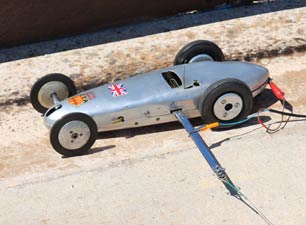 |
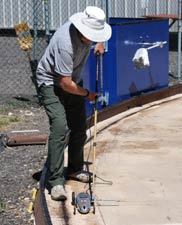 |
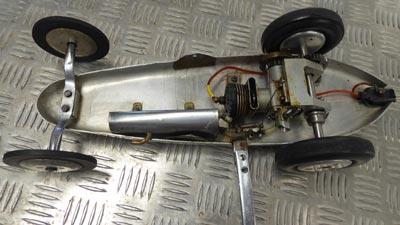 |
| 65+ years on from its last run | 'Herself' pushing off | Simple layout and lots of space |
|
|
New arrivals each day with John Goodall, Ian Harper and Bill Bannister completing the line up. We have not seen Bill for a while, but he is another one that builds and runs his own engines, in cars he has built, with tyres he has moulded. John is still trying to get the Oliver twin to run on both cylinders but now thinks a rebore is required to get both chiming. His lovely Vanwall looks so nice on the track at modest speeds, but further runs were negated by a problem wit the 3D printed curly carb. Ian had a day he would probably prefer to forget having found a leaking fuel tank in his Terry Special that he bought recently and an unfortunate occurrence that wrecked the Slabang style front suspension of his 1958 Zetterstrom Dooling car. Left: Zetterstom car before its happenstance |
It has to be said though, that running cars in that
heat is somewhat debilitating and with the temperature in the hotel room
hovering around 29C, sleep was also difficult, but the chat and bouncing around of
ideas always makes for a good weekend. The cafe was also doing a roaring trade
in ice creams. Successful runs do add significantly to the enjoyment of any
meeting, especially if it is a car last run in 1958. Just a reminder though
about this wonderful product called Loctite and the old maxim, if it can break
it will and if it can come undone, then it certainly will.
Video footage
www.youtube.com
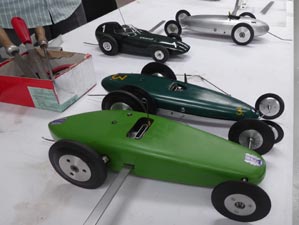 |
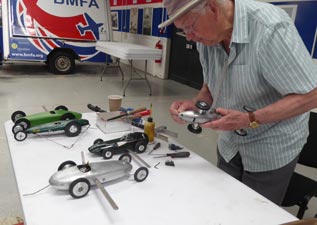 |
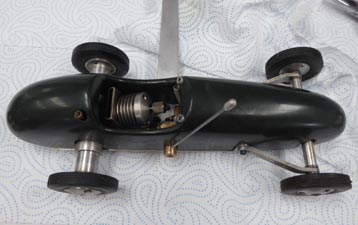 |
| Ian and John's cars | John with the Tiger Bomb | Bill Bannister's 2.5cc twinshaft |
|
|
Summer at last
Buckminster Tether Car Group |
|
Easy to believe that it was now August and holiday time as we had gone from the roasting we experienced at the previous meetings to the promise of rain and more modest temperatures. Luckily, apart from a bit of drizzle on Friday morning, the rain did not materialise, but by Sunday it was perishing out on the field but our little corner was protected from the worst of the wind. Thursday was devoted to track maintenance, thanks to Ian Harper for travelling down to help with the dusty bit and Nigel for completing the electric installation to the timing hut. John and Neil from the Buckminster volunteers came and did all the mowing and strimming with Lynn acting as gofer. Thanks to Manny Williamson for organising the volunteers and providing the cable protectors. Somehow all this took up the whole day, but enabled a prompt start on Friday, well it would have done had it not been mizzling all mornings.
 |
 |
| Ian and Hugh on their second tub of Isopon | Nigel installing external socket |
What this did allow us to do is to further investigate the results of an ongoing discussion about providing alternative ways into the sport now that the Redfin project is finished, and also offer some sort of progression from the 2.5cc diesel cars. The Redfin and TMP engines are ideal as they can be mounted easily and require little engineering to have a car on the track, but supply is drying up, especially as the Redfins are now collectors items and changing hand for up to double what they were originally sold for. The KMD and Eureka are beautiful and powerful alternatives, but being converted aero engines are more difficult to mount. The embargo on trade with Russia has meant the 2.1cc kits from Lev Shprints have also dried up, which were ideal as he offered one stop shopping.
 |
 |
| First trial of RC car based motor | Novel mounting system for 'aero' twinshafts |
So far, John Goodall has come up with a British version of the SMRU car based on a casting that takes a 2.5cc aero engine driving a single wheel. After a lot of chat, Nigel Bathe produced a 'proof of concept' model that uses a standard 3.5cc buggy or on road RC engine, which are freely available, even to the extent of lifting the entire drive train and front suspension from an existing car. Roger Gedge has come up with a novel idea for mounting a converted aero engine in addition to the electric cars he has been working on. Plenty of alternative routes to explore. We have to accommodate the fact that workshop facilities and engineering skills are on the wane and ARTF and RTF models offer so much to other disciplines.
 |
 |
 |
| Nigel 'fettling' | Castings for the OBC single ender | Lev Shprints unit |
Too much thinking was responsible for another concept being no more than parts laid out on a piece of paper, but Nigel's was on the track. At first it was reluctant to go until a change in gear ratio had it singing away. Concept proved, now to turn it in to a viable car. The others ideas are still 'work in progress', but to do nothing is not an alternative.
After lunch the action on the track was thick and fast, although everything was a tad slower than previously. Mike Francies has his cars now well in excess of 100mph with the 2.1s all approaching this speed and the various twinshafts up to the mid 80s. A bit of a puzzler is Mike's KMD that has been converted to glow, but a couple of trial runs proved a long held theory that engines do not like to swallow their own exhaust. With the body on, drones round, body off, normal speed. The rules for the modern British classes do not allow for tuned or mini pipes, but it is clear that some method of separating intake and exhaust is required. Andy Soars has solved this with a plenum chamber for the intake on his TMP car. The Fora type engines are something of a problem in this respect as they have an angled exhaust stub facing the wrong way.
 |
 |
| From FEMA Class 3 to true vinatge 2.5cc | An eclectic mix awaiting |
With power in the timing hut it was a chance to try out all the systems with the three minute warning, the computer to record runs and the printer. We are getting there and slightly cheaper than the 3,500-4,000 Euros the system being developed might cost?
 |
 |
|
Computer to record runs and printer for results |
Start timer showing 2 mins |
One of our larger turnouts of the season on Saturday with John Goodall giving his Oliver 'Tiger Bomb' its first couple of runs. Teardrops and bomb shaped cars are odd in that nearly all the weight is concentrated on the drive wheels making them very bouncy at the back ends and difficult to horse. Excessive wheel spin can also make it difficult to keep the cars on the track after the launch. John also gave his Vanwall another run to bed the engine in a bit more. It will go a lot faster, but should it, a question Bill Boddy, Editor of Motor Sport, posed in the model car magazines back in the late 40s. Ian Harper had repaired his 1958 Zetterstom Dooling, which starts and runs superbly at around 90mph.
Following MiJee's wonderful chocolate cake and goodies celebration of Charlie Murphy's birthday at a previous meeting, it was decided to repeat the process, but this time for a wedding anniversary. Instead of chocolate it was coffee and walnut with coffee cream on top, luverly and by courtesy of Sandra Tricker who bakes marvellous cakes for the Thursday volunteers. It's on the off chance of scrounging a piece of her cake that gets us there on a Thursday, not just track maintenance?
Not a wonderful weekend for mechanical maladies as David Giles' ultra dependable Nordec Conquest never came anywhere near its normal speed and came to a halt in a cloud of smoke with no sign of any compression. Mike Francies found a small fragment of metal in the pan of his car, which turned out to be a whole tooth from the drive pinion, that somehow had not affected the running of the car? Less happy still, even after a piece of cake, was Lyndon Bedford who after ending up with a two piece crankcase at the last meeting had the front housing on the replacement ETA 29 in his bevel drive car succumb to old age This led to much conversation between him and Bill Bannister about crank supports and billet housings as ways to overcome this. After all, the youngest of these engines is over 65 years old. Worse was to come as his vintage 2.5cc car found a bump it did not like and took the mop head clean off the stopper before completing the lap upside down. Not sure that he appreciated the ceremonial presentation of the tattered remains, luckily there is always a spare in the cable box. The last time we saw this happen was with a car doing 200mph that took the mop head off, then hit it every lap until the car stopped. Lyndon's school's car with the ETA TMP motor was also looking a bit lively, demonstrating why skids with hard metal tips are required. Three instances also of why wheel nuts should be introduced to Loctite?
 |
 |
 |
| More broken ETA | Deranged OPS big end | New tyre moulds |
|
|
Long faces in the OTW camp as well when the first run with a new 5cc FEMA type car came to an abrupt halt. This car was built purely to run at Buckminster with fully damped suspension and an OPS 29 so that it would not go too fast. Well it was just getting towards too fast when the Achilles heel of the OPS, the big end bearing, let go, thankfully with no debris going through the motor or any other damage. This is a class that has its own competition in Sweden, so it should work. The mood did not improve when a third run with the new 2.1car had it upside down as it hit 90mph for the first time, happily and hopefully, cosmetic damage only. |
|
Roger was running his electric cars, again slightly down on speed, but at the cost of a tyre per run, an ever increasing problem. Mike Francies is moulding tyres in two types, beaded and now a larger, steel cored type, for which he had moulds on show. For once, Jan Huning left with his tyres still round after several runs with his little home built twinshaft in the Tiger Two-Five. This engine is remarkable as it starts with a flick of the wheel, no electric starters required. This car must now hold the record for the most laps completed both at Gt Carlton and Buckminster. Not far behind is Chris Maggs with his TMP 'Red Thing' that was back on the 'ready table' almost as
quickly as he could refuel. |
|
Given the forecast for Sunday it was decided to pack everything away on Saturday and then start again on Sunday, if it was dry. Well, it was, much to the delight of the flyers, although seriously windy. Just a few runs in the morning as most of us had enjoyed as much running as we wanted or were contemplating more workshop time before the next meeting. Having a bit of spare time, and after an invite from Alan Knight, we wandered over to the flying circles where a vintage combat meeting was in progress. Suddenly you realise that the odd scuff mark or iffy big end is a minor consideration as the flyers reduced planes and expensive engines to scrap in minutes, but then got out another one to continue the carnage, all in the name of enjoyment. Watching other modelling disciplines is never less than fascinating and often very illuminating as well. Consensual mayhem best describes what we witnessed.
|
|
First
Records weekend
Buckminster Tether Car Group |
|

As has been the tradition over the past years, the September BTCG meeting involves some form of novelty or special element to add a bit of spice. This year Oliver came up with the idea of a records weekend. The last official tethered car records in the UK date back to the late 50s when there were British and Open classes and records for varying distances. Since then, the only British records have been those achieved with modern cars at FEMA tracks. The plan was not to break the old records but to establish new benchmarks for the classes we run at Buckminster. Sixty five years on and it should not be impossible for retro style cars to match the speeds from the 50s, but time would tell. Nigel Bathe and Roger Gedge have been the closest to the 2.5cc speeds achieved in the day, but the 5cc cars are a way away and no one has been brave enough to run a 10cc flat out yet. The fastest recorded speed so far is 146mph with a FEMA 3.5cc car, so how would everyone fair?
|
It is unfortunate that the exceedingly dry summer has not done the track any favours, yet it was ironic that the track and infield never dried up enough on the Thursday to allow any maintenance or mowing. We had another task to attend to as we had to deliver a huge collection of engines from our late President Stuart Robinson for inclusion in the November auctions. Oliver had also brought along a car full of boxes and trays with a couple of 3b cars and a huge assortment of bits and pieces from Stuart for sale that weekend and the October swapmeet, with all proceeds very kindly donated to the BTCG funds for the track by Stuart's widow. (Right) |
|
Friday was open practice and free running, delayed for a while as the grass infield would not dry out enough to allow it to be mowed. Eventually Mike was able to do a sterling job with the new mower, Lynn on regular grass box emptying duties and track sweeping as the leaves were falling as fast as she was sweeping. These would later cause all sorts of issues with the timing sensor. With the largest turn out of the season there was plenty of track action, although almost every car was slower than at previous meetings. Gerry Best struggled all weekend to get settings on his 2.5 and 3.5cc cars, never managing to get a run. Mike Francies who has consistently been achieving the fastest runs this season with his 2.5cc modern British car had a damper give up the ghost, which wrecked the bodywork on the car with bits of blue plastic spread liberally about. Nigel Bathe was changing engines to get one that worked well.
 |
 |
 |
| Nigel changing engines | Mike's modern British 2.5s and 2.1 | The errant damper |
The runs to set records would be run under FEMA competition conditions, with a 3 minute start timer, except, as the technology minded Jan and Ian pointed out, as it was on loan from the French it was designed to run on old French 60hz electricity. On our slower 50hz supply 3 minutes was a lot longer than it should have been, so it will be the 2 minute setting in future. Almost everyone is now able to start and complete a run well within the time. It was a pleasure to welcome Tony Collins, an ex hydro competitor who was having a first serious go with a 2.1 car, getting three runs in, the best over 90mph.
 |
 |
| The procedures being explained | Tony Collins' first run |
Bill Bannister was back with his home built engines and Jan Huning managed numerous runs without suffering tyre problems for once. Roger Gedge was finding that each run was costing him a tyre as they were stripping out of the beads. He has been doing a great deal of work developing his electric cars, now running without transmitters and an internal potentiometer to set speed before the run. He had turned the 'wick' down a bit too much as the cars have run happily at 100mph. After discussion he is now working on a completely automatic run programme with an emergency knock off and an arming link to ensure a specification so that electric cars meet the very highest safety standards. Thank you Roger for all your work refining the systems and explaining it all to us IC aficionados.
 |
 |
| Roger's electric car being hitched on | All the 'works' |
John Goodall had arrived with his Maserati project that is nearing completion although he was less than happy with the stove enamelled finish that was being returned the following week to be redone. (full article on this amazing project to follow) His Redfin Vanwall very much looks the part on the track. He had also brought along the first of the SMRU based OBC cars for discussion about body shells. With no more twinshaft engines available it will be interesting to see what alternative designs are forthcoming. The lack of available parts is seriously holding back development at Buckminster. Oliver Monk had his new 1.5cc car with a steel backbone chassis that was proving a real pain. It would start and run up to speed and then the motor would stop until the car was almost at a standstill before chiming in again, only to repeat the process every lap. Probably a record if only for the slowest speed yet it baulked at every modification Oliver tried. Something basic no doubt, but what?
 |
 |
| Three vintage, one repro vintage, one much modified schools car | Oliver's 1.5 and an Oliver with a spur mounted motor |
Andy Soars had his very pretty Ferrari 312T with a now modified TMP motor although it was experiencing tracking problems. Lyndon Bedford had another torrid weekend with only his ETA/TMP schools car performing and lots of bits on his table. There were also lots of bits on the sale table, but happily these were being snapped up at a rapid rate, raising a considerable amount for funds. As Stuart had been our Association President it was necessary to find someone else to take the position, and happily, David Giles, our most recent European Champion, agreed.
By 3pm, everyone had either broken what they brought or had enough runs so that Oliver was able to announce the new records, each well below what had previously been achieved.
2.1cc Class Nigel Bathe 94.842mph
2.5cc Modern British Mike Francies 84.235mph
2.5cc Retro Lyndon Bedford 82.247mph
Electric Roger Gedge 79.347mph
Live action go to www.youtube.com
There will not be a specific records weekend in future, but any run in a BTCG organised competition can claim a record if the above speeds are exceeded or new marks set in the remaining classes. Thanks to Oliver for proposing and organising the weekend. Well that was it for 2025, five well supported meetings so thanks to everyone who has been involved in any way, especially Oliver, Aaron, Ian, Nigel, Lynn, Hugh and the Buckminster volunteers for all the work that has allowed the events to go ahead and to Manny for use of the hangar as a shelter from the sun, rather than the rain of last year. The Flyers cafe has been a great addition so thanks to Gill and Beverly for keeping us fed and watered.
The programme for 2026 should be available around November when dates are agreed with Manny Williamson.
ęcopyrightOTW2025